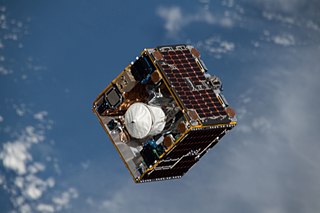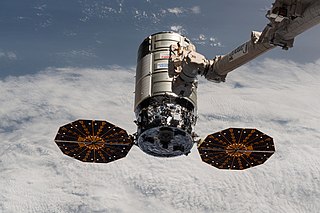
The Japanese Experiment Module (JEM), nicknamed Kibō, is a Japanese science module for the International Space Station (ISS) developed by JAXA. It is the largest single ISS module, and is attached to the Harmony module. The first two pieces of the module were launched on Space Shuttle missions STS-123 and STS-124. The third and final components were launched on STS-127.

A CubeSat is a class of small satellite with a form factor of 10 cm (3.9 in) cubes. CubeSats have a mass of no more than 2 kg (4.4 lb) per unit, and often use commercial off-the-shelf (COTS) components for their electronics and structure. CubeSats are deployed into orbit from the International Space Station, or launched as secondary payloads on a launch vehicle. As of December 2023, more than 2,300 CubeSats have been launched.
RAIKO is a Japanese satellite which was built and operated by Tohoku and Wakayama Universities. A two-unit CubeSat, RAIKO was deployed from the International Space Station (ISS) on 4 October 2012, having been launched on 21 July 2012.

F-1 is a CubeSat built by FSpace laboratory at FPT University, in Hanoi, Vietnam, in partnership with Angstrom Space Technology Center (ASTC), Uppsala University, Sweden and Nanoracks LLC, United States. Its mission is to train young engineers and students about aerospace engineering and evaluate an advanced three-axis magnetometer, Spin-Dependent Tunneling Magnetometer (SDTM) designed in Sweden by ASTC.
Technology Education Satellite (TechEdSat) is a successful nano-sat flight series conducted from the NASA Ames Research Center in collaboration with numerous universities. While one of the principal aims has been to introduce young professionals and university students to the practical realm of developing space flight hardware, considerable innovations have been introduced. In addition, this evolving flight platform has tested concepts for Low Earth Orbit (LEO) sample return, as well as planetary nano-sat class mission concepts.

Kounotori 3, also known as HTV-3, was the third flight of the Japanese H-II Transfer Vehicle. It was launched on 21 July 2012 to resupply the International Space Station (ISS) aboard the H-IIB Launch Vehicle No. 3 manufactured by Mitsubishi Heavy Industries (MHI) and JAXA. Kounotori 3 arrived at the ISS on 27 July 2012, and Expedition 32 Flight Engineer and JAXA astronaut Akihiko Hoshide used the International Space Station's Canadarm2 robotic arm to install Kounotori 3, to its docking port on the Earth-facing side (nadir) of the Harmony module at 14:34 UTC.

Orbital-1, also known as Orb-1, was the second flight of the Orbital Sciences Cygnus cargo spacecraft, its second flight to the International Space Station (ISS) and the third launch of the company's Antares launch vehicle. The mission launched on 9 January 2014 at 18:07:05 UTC.

Nanoracks LLC is a private in-space services company which builds space hardware and in-space repurposing tools. The company also facilitates experiments and launches of CubeSats to Low Earth Orbit.

WE WISH was a small commercial CubeSat which was deployed from the International Space Station (ISS) in October 2012 and which deorbited in March 2013. It was built by the Japanese technology company Meisei Electric and the Meisei Amateur Radio Club, and could transmit pictures taken by a small infrared camera via radio at 437.515 MHz. WE WISH travelled to orbit aboard Kounotori 3 (HTV-3) on 21 July 2012, along with other CubeSats including RAIKO, FITSAT-1, F-1, and TechEdSat-1.

AESP-14 is a Brazilian 1U Cubesat developed by multiple Brazilian institutions. It was launched on 10 January 2015 aboard the SpaceX CRS-5 mission on a Falcon 9 v1.1 rocket. It was the first Brazilian Cubesat ever launched into space.

The Nanoracks Bishop Airlock is a commercially-funded airlock module launched to the International Space Station on SpaceX CRS-21 on 6 December 2020. It was berthed to the Tranquility module on 19 December 2020 by the Canadarm2. The module was built by Nanoracks, Thales Alenia Space, and Boeing. It is used to deploy CubeSats, small satellites, and other external payloads for NASA, Center for the Advancement of Science in Space (CASIS), and other commercial and governmental customers. NASA plans on using the airlock as a brand new way to dispose large pieces of trash. The name refers to the bishop chess piece, which moves diagonally.

PicoDragon is a small satellite that followed the 1U type of CubeSat program built by the Vietnam National Satellite Center (VNSC) which belongs to VAST and operated in space for 3 months.

BRAC Onnesha was the first nanosatellite built in Bangladesh to be launched into space. The satellite was designed and built in conjunction with Kyushu Institute of Technology Birds-1 program, which has the goal of helping countries build their first satellite. It was designed and built over a two-year period.

RemoveDEBRIS was a satellite research project intending to demonstrate various space debris removal technologies. The mission was led by the Surrey Space Centre from the University of Surrey with the satellite's platform manufactured by Surrey Satellite Technology Ltd (SSTL). Partners on the project included Airbus, ArianeGroup, Swiss Center for Electronics and Microtechnology, Inria, Innovative Solutions In Space, Surrey Space Centre, and Stellenbosch University.
UBAKUSAT was a Turkish nanosatellite that was developed by Istanbul Technical University. It was launched into space on board a Falcon-9 rocket in April 2018 and was deployed into its orbit from the International Space Station in May 2018. It was built as a technology demonstration and Earth observation satellite to provide voice communications for amateur radio stations around the world. It carried an experimental card, TAMSAT Simplesat, which allowed scientists to test its accuracy of measuring radiation from space. It was the fifth satellite to be built by students of Istanbul Technical University.
AQT-D was a nanosatellite project of the University of Tokyo (UT) Space Propulsion Laboratory with the purpose of testing water-fueled propulsion. The satellite was a CubeSat of 3U size; 1U was occupied by the propulsion system, while the remaining 2U was for the spacecraft bus. AQT-D was carried to space inside the pressurized section of Kounotori 8, a Japanese resupply vehicle for the International Space Station (ISS). Kounotori 8 was launched on 24 September 2019. After arriving at the ISS, AQT-D was deployed to space on 20 November 2019 using the JEMRMS robotic arm at the space station's Kibō laboratory module.

NG-14, previously known as OA-14, was the fifteenth flight of the Northrop Grumman robotic resupply spacecraft Cygnus and its fourteenth flight to the International Space Station under the Commercial Resupply Services (CRS-1) contract with NASA. The mission was launched on 3 October 2020, at 01:16:14 UTC.

NG-15, previously known as OA-15, was the fifteenth launch of the Northrop Grumman robotic resupply spacecraft Cygnus and its fourteenth flight to the International Space Station (ISS) under the Commercial Resupply Services (CRS) contract with NASA. The mission launched on 20 February 2021 at 17:36:50 UTC. This is the fourth launch of Cygnus under the CRS-2 contract.

SpaceX CRS-26, also known as SpX-26, was a Commercial Resupply Service mission to the International Space Station (ISS) launched on 26 November 2022. The mission was contracted by NASA and flown by SpaceX using a Cargo Dragon. This was the sixth flight for SpaceX under NASA's CRS Phase 2 contract awarded in January 2016.















